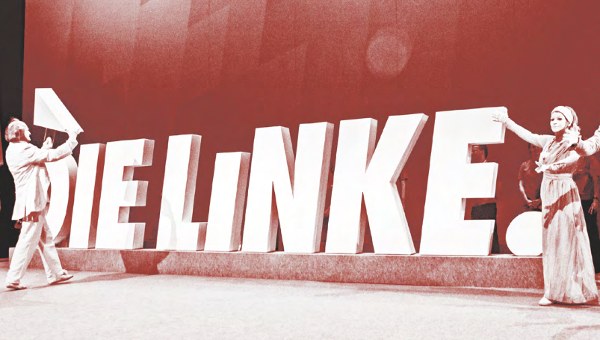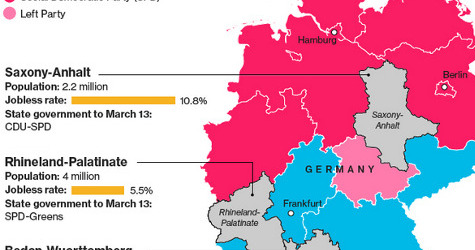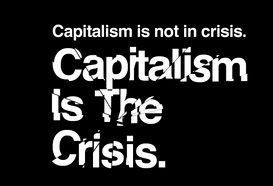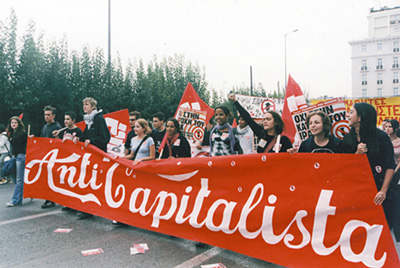Die Linke: Now What?
Three Suggestions for a Left Strategy Discussion
Society is being transformed. The party system is in a state of upheaval. Parties continually find themselves in troubled waters, and Die Linke (The Left Party) is no exception. The future itself has become uncertain. In which direction should the party – and society as a whole – move? This is what is at stake. In such a dynamic situation, what strategies will clearly demonstrate Die Linke’s value. How can the party become effective socially? There is no blueprint for any of this. Of course, not everything has to be re-invented; we can draw from many existing approaches. But what is needed is a critical, forward-looking discussion about these approaches that is grounded in solidarity. To this end, the party is going to organize a strategy conference. This contribution is intended to provide stimulus for a party sharpening its profile by producing selected and exemplary conflicts of connective and social-ecological class politics, by providing a socialist perspective, and by developing clear project proposals for a left government.
Our Starting Point: Three Poles Amidst Social Crisis
As in many other countries, Germany’s party system has been in turmoil since the onset of the major crisis. However, this situation is better than the relative stalemate of fully-developed (neoliberal) hegemony. New awakenings are taking place throughout Europe, just as in Germany. These upheavals are, without a doubt, highly dangerous. The direction that these dynamics take can be unpredictable, and they have already left many parties from all political camps in the dust. The most recent elections in eastern Germany and the European elections before them are a clear warning sign, though they do not represent the general tendency.1 The crisis at hand is, therefore, not restricted to Die Linke but is a broader social crisis that is transforming every party and several different countries.
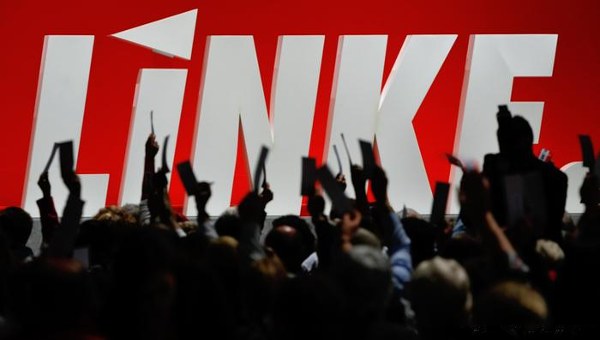
A constellation has formed which can be described as a threefold polarization: the first pole is made up of the power bloc currently in office (and the capital factions that support it), or the “small power blocs” in the Länder (German federal states) (awarding the Prime Minister a bonus as a pillar of stability and to prevent the radical right party AfD from becoming the strongest party). The second pole is the Alternative for Germany (AfD), whose growth slowed down but which is strong and whose discourse is influential. It represents the real “challenger” to the government and the established parties in general. The third social pole stands for defence of a mode of living based on solidarity and democracy, as well as the ecological foundations of society (which became evident in Saxony as well, when 90 percent of participants at the #unteilbar – #undivided – demonstration in Dresden were from regional areas). This third pole has found representation in a political party, but unfortunately, Die Linke is not (or only partly) that party: the Greens (Die Grünen) are.2
Not only are nuanced or intermediate positions barely visible in such a polarized constellation, they are often crushed. Die Linke is barely noticed; it only features in the media in exceptional instances, such as when issues like rent (control) in housing come up. This also has to do with regional issues: the strength of the former Party of Democratic Socialism (PDS), now Die Linke in East Germany, was its large (even if older and often passive) membership combined with a loyal constituency that identified with the party. Many of these members were recruited from the staff of the former Socialist Unity Party of Germany (SED) and its milieu. Within 20 years, this generation of members and voters will have completely disappeared, which will reduce the party’s local presence and embeddedness. If it does not commit to creating a new membership and constituency, it risks perishing as a generational project from the East. Other factors include several mistakes (keyword ‘police law’) and a style of politics focused on small reforms, “better” government or “better” opposition, and the limited space of parliamentary politics on the “spirit of separation” (Antonio Gramsci), on a clear distinction and a sharp, recognisable profile in face of other parties. But the form of party as an “anti-neoliberal coalition movement” (Jörg Schindler), as reaction to the “Agenda 2010” and the introduction of workfare reforms in Germany, also has exhausted itself, while new strategies, like those of an organizing and connective party and a new class politics, haven’t had the time to spread through the whole of the party (or were even partially blocked).
Despite good work, this could easily turn into an existential threat, especially in political constellations like the one mentioned above between the Christian Democratic Union of Germany/Christian Social Union in Bavaria (CDU/CSU), the Greens and the AfD. It is precisely this – and not the mistakes that have always been made – which characterizes the precarious situation the SPD finds itself in, and which Die Linke risks falling into, as well. An understanding of these constellations is important if we want to be able to accurately assess problems and opportunities and avoid defeatist and destructive moods. Time and time again, we come up against the attitude within Die Linke that bad-mouths the organization itself, and that pays more attention to inner rifts than to the real opponents, where, in discussions, the struggle is to divide rather than to connect, and both sides accuse the other of having no strategy. But a party that strips itself of its own courage is seriously fighting for its life. You have to be able to afford defeatism – we are not in the position to do this.
This constellation of threefold polarization need not remain the case. The dynamic is highly volatile. By German standards, civil society is at least partially mobilized: even in the East one can find an abundance of small initiatives campaigning against the radical right, campaigning around local concerns, Fridays for Future and other people mobilized by climate change, in the cities as well as in small towns in Lausatia and elsewhere – the huge political demonstration of #unteilbar (#undivided) in Dresden was one example of this. There is also a new generation of union activists close to Die Linke, not least because the roots of unions in the East are far less influenced by the SPD than in West Germany. In the last few years many young people from the East have also joined the party. New members cannot compensate for the loss of the older generation, but as with the national average, it is overwhelmingly younger new members that are starting to take action against the right, against an overall development perceived as threatening, and for a local left-wing politics, practiced locally and with the community. The positive developments of the student association Linke.SDS, the Leipzig branch of which is one of the largest and most active groups in the country, shows potential for the party. Social polarization politicizes people. All this also helped win the elections in Thuringia and Bremen.
But the party’s development is characterized by strong asynchronicities. Voter abstinence and political passivity in certain class sectors (which are especially important for Die Linke) remain high. This is not (only) a question of having the right rhetorical approach to the people. Projects and practices must be developed that go above and beyond the usual suspects to embrace and even be driven by those “below,” whether or not from migrant backgrounds. The party itself must again become a living, organizing political organism. These practices are a litmus test for a new class politics. It is a matter of determining the function of a socialist party.
Possible Strategies and Priorities
How should we act in volatile times? How can we break out of the current situation, in which Die Linke is hardly visible? The strategy of a connective class politics and transformative organizing has proved effective in many areas. It is capable of mobilizing people and drawing them into concrete social struggles and motivating them to become members. But this is a long-term strategy, and it takes time (and is far from being systematically anchored in the party or in social movements). The populist (media) strategy of initiating a “movement” from scratch has failed (and caused considerable damage to the party). This has shown that it does not make sense to focus only on a few of Die Linke’s voter groups (groups of threatened employees in industry, often erroneously referred to as the “working class,” or the “urban centre” in contrast). And we also can’t “copy” the Greens (to whom, after the non-voters at 1.1 million, we lost the most votes in the European elections, 700,000, and this is not to mention the many voters who have turned to the AfD, the SPD and the CDU). Yet the cliché that a “greening of the party” is taking place is not true: “Die Linke has … the highest proportion of workers amongst all parties, just ahead of the SPD.” They are the only party to have members from the so-called “lower class (34 per cent),” and by a large margin. In the case of the Greens, the opposite is true: “Die Linke and the Greens are thus growing further apart socially,” according to the largest study on the developments in membership of German parties.3
Die Linke must connect very different sectors of the class. It must always learn to translate anew. Class divisions abound in many ways, along professional and generational lines, along the lines of formal education, gender, ethno-national and other (self-)attributions, and regarding respective positions within the process of social (re-)production. It’s always about making and re-making of class: it has never been any different. It is important to focus on wage earners as “individuals as a whole” (that is, on their mode of production and living). This implies a different concept of interest because each individual has many different interests, some of which are opposed such that the contradiction runs directly through the subject. In this respect, interests are not “objectively” given, but are permanently being shaped through struggles, at best in common struggles. Then the struggles, too, are all the more diverse. One of the most powerful sources of discord is the intimate link between racism and class politics from “above.” Against this, we need to develop an effective socialist class politics as a kind of connective antagonism.
Connective Class Politics and Socialism
Here, we discuss two directions (see below): a popular strategy and a “populist” strategy, both of which are connected and which could definitely complement each other. It is crucial to identify some projects that bring about immediate improvements, and at the same time, change power and property relations – with the deliberate aim of producing exemplary conflicts. This was achieved by Charité employees on the question of staffing levels in the biggest Berlin hospital, and also applies to the “Deutsche Wohnen & Co enteignen” initiative (a campaign for a referendum to expropriate big real estate owners) – both started locally and then inspiring countrywide support. A targeted conflict should address everyday needs, aim at immediate improvements for the individual and create a dynamic for the next steps and subsequent perspectives. This includes disruptive practices such as strikes, occupations, and blockades – as well as referenda. This self-empowerment and a long breath are central to expanding the scope of possibilities – until recently, we would have never imagined that a campaign to expropriate real estate companies would be successful under any circumstances. Conflicts like this provide visibility, inspiration and motivation. A political campaign oriented around these kinds of struggles offers concrete opportunities to connect previously fragmented initiatives and organizations. If successful, it will shift social discourse, and maybe even the relations of power, expanding the scope of possibilities and strengthening other demands (for example, the expropriation campaign has directly improved the discourse around rent control and inspired radical ideas in other fields). As can be seen when city district-level organizations lead successful local campaigns, connect with other groups and provide a sense of belonging, these disputes can be tremendously enjoyable. Even for those who cannot or do not want to become active themselves, these struggles can radiate a new appeal: they get the feeling that someone is really fighting against powerful interest groups on their behalf, not abstractly, but to achieve something concrete. The organizing work – connecting, broadening, anchoring – is central to becoming more numerous. This can combine (self-)organization with a living and organic representation. What, then, are the three or four central social questions that must be solved and that are likely to develop such a productive conflict for the left?
Answering requires naming the opponents. Tactically and strategically, identification should be as precise as possible to avoid making the opponent abstract. Researching investors’ backgrounds or the machinations of a company are good examples of this. Who is profiting from this or that hospital corporation at the expense of patients and staff? Who delivers which military equipment to crisis areas? Who is using diesel fraud and corruption to block an ecological transformation in transport? The goal is a targeted blaming of opponents. Having a sharp, compelling tone to our own political language is part of this. Thus, a connective, socialist class politics can figure out why struggles for better working conditions, for wages and time, but also for reproduction – health, housing, ecology – still remain class struggles. This is not obvious in the industrial sector (with its tradition of social partnership, export corporatism and digital pacts), and is even less so in the service sectors, and least of all, in the area of public social infrastructures or climate issues. For example, it is said that in the ecological crisis we are all in the same boat, that even the rich will not escape it. This is nonsense considering the extremely unequal class distribution of causes and consequences, both globally and within a given society. In addition to referencing opponents, there is always a need for connective (usually quite general) slogans for system change, but also for positive projects that consist of a mixture of achievable goals and forward-driving demands and initiatives.
In times of social polarization, a radical perspective is crucial. It is not simply a matter of defending the welfare state or returning to a nation-state model of regulated capitalism. We should make it clear that we are advocating for the end of capitalism, for a society that Bernie Sanders doesn’t hesitate to call socialism. This includes things that go without saying, such as free healthcare and education, and affordable housing for all; free public goods and services, from libraries to public transportation and the networks of the “basic economy of everyday life”; much more time for each other and for life itself; democratic participation that makes a difference, that is, real democracy. Socialism would first and foremost be the right to what is self-evident.
This involves updating old socialist problems like questions of power and property relations, redistribution, planning and democracy, and linking them to new problems. They are all part of a perspective that aims to extend collective control over immediate living conditions, the social means of production and reproduction.

A decidedly socialist perspective can be helpful in two ways: first, through an open and offensive search process, it can offer a perspective that reconnects different fields, to avoid everything being reduced to individual policies and initiatives. Second, it can link the different interests and movements in the sense of a “revolutionary realpolitik” such that it does not “only set itself achievable goals that it pursues to obtain by the most effective means in the shortest time,” but rather goes “in all the parts of its endeavours beyond the bounds of the existing order in which it operates.”4 It links distribution issues with issues of power, property and democracy that (want to) go to the root of the problem.
We may already be in a situation in which we are forced to make a decision. The rise of global inequality, ecological crisis, migration movements, global authoritarianism and nascent fascism all make it absolutely necessary to break with the old neoliberal as well as the new authoritarian policies. In a kind of inverted rainbow, i.e., against purple, pink, green and multi-coloured, the radical right constructs “the other” as a figure to mobilize against, part of their resistance to the supposedly “moralizing re-education” of the 68ers. Our criticism of the one-sided liberal orientation toward recognition should by no means come at the expense of the achievements of emancipatory struggles for recognition. The equality of women, recognition of gay or lesbian modes of living, diversity of sexual orientation, cultural openness, taking small steps toward a more ecological way of life, etc. were all gains won by these movements, and they must be defended. It takes more rather than less. And a central target of authoritarianism are social, collective, political and democratic rights, which must be defended as well. The radical right aims to divide the subalterns by constructing a right-wing identity politics and reactionary self-empowerment. It makes no sense for the left to play off the individual elements (social, feminist, ecological, etc.) against each other.
A more serious economic downturn would aggravate the social situation even further. At large, the “middle course” of post-ideological openness, pragmatism and left-liberal criticism is no longer feasible. Forces that want to work for the preservation of liberal and civil liberties and minimal standards of living based on solidarity must take sides against authoritarianism and neoliberalism, which entails advocating for a more radical left orientation. Now is the time to decide, in an interregnum when different possibilities are still open but are already beginning to close. Barbarism is conceivable again – indeed violent struggles are the norm in the transition to a new societal project (whether capitalist or not); a socialist project can invoke necessity due to unresolved, escalating human problems and the danger of barbarism while at the same time feeding on desires and longings for the future, for concrete utopia. A socialist “narrative” is indispensable, but at the same time, it must be very concrete, and be developed from socialist interventions. The adjective “socialist” refers to a practice, not a finished blueprint.
Red-Red-Green? No, Left Government!
We already discussed the chances for a left-wing government before the last German general elections in 2017.5 But this is also another opportunity to make the use value of Die Linke clear, at least if it manages to not just participate in a coalition government but to make a real difference. We are all familiar with numerous examples – from Greece to Brandenburg – in which making a real difference was only possible to a very limited extent. But the situation has changed. In times when neoliberalism was completely hegemonic, the vast majority of government participation from the left was doomed to failure. Yet sometimes they had no choice. Left-wing parties felt compelled to participate in government if only to prevent a second Berlusconi government in Italy or to replace the corrupt CDU government in Berlin. In both cases, however, the consequences for the left were fatal. In the meantime, neoliberal hegemony has disappeared. The rulers uphold their rule in an authoritarian manner, with domination, but they no longer lead, and support for them is collapsing everywhere. Left-wing governments in Greece or Portugal, in the rebellious cities of Spain or Italy, show how enormous the challenges are, but nevertheless, how significant achievements can be made.
We can take Berlin as an example of how much left movements and the left party are capable of learning to facilitate an effective division of labour, solidarity-based criticism and shared successes. The fact that in the Berlin government coalition no large party dominates (two) smaller parties anymore because electoral results for the three parties have become much more similar really facilitates cooperation at eye level. The new Bremen coalition in government will mark a new field of experimentation.
At the federal level too, we should clearly state our strategic goal: not simply a red-red-green (R2G) coalition because it is arithmetically possible, or opposition because government is useless anyway; rather, Die Linke should stand up for a decidedly left government that can count on a strong civil society to be its critical partner. A minority government is also conceivable, since this can sometimes be advantageous for the left (as in Portugal). Either way, we can no longer afford to only make small corrections. Govern only when a change of direction is possible: that is the key prerequisite for an enduring politics of hope.
For any kind of participation in government, a few concrete, ambitious projects (which should be realized in any case) are necessary. We should take seriously the kinds of programmes our potential allies on the left are making, and seek out commonalities. Some examples of this include the following: a sanction-free basic social safety net; the substantial reduction of arms exports (prohibition in crisis areas); initiatives for the (permanent) construction of social housing (with investments, but above all with significantly more rights for tenants and municipalities in tenant law); the strengthening of social infrastructures with binding staffing levels in social professions, including nursing care for the sick and the elderly as well as (problem) schools; radical measures in climate policy (earlier withdrawal from coal, massive investments for structural change, social-ecological investment programmes, stricter limits and regulatory measures in transport and elsewhere); the expansion of local and regional public transport with affordable ticket prices and steps toward a car-free city; taking freight transport off the roads and onto rail; the regulation and severe restrictions on temporary work, fixed-term contracts, and other precarious work form; an orientation toward new standard working conditions and a higher minimum wage; the re-appropriation of digital data and the regulation of the platform economy and logistics; and in particular, wealth and corporate taxes, a transaction tax, tax enforcement for transnational and tech corporations; and finally, measures to democratize the state and entries into economic democracy. This list is already too long. The priorities among the aforementioned points would perhaps be housing, a transformation of transport, sanction-free basic social safety net, care infrastructure and arms.
It is crucial to identify some projects that bring immediate improvements while at the same time change power and property relations, thereby producing exemplary conflicts. Drawing lines in the sand or “no-goes” concerning government participation only helps define the party negatively; it does not demonstrate the party’s usefulness in government. It also makes sense to refrain from certain actions: no free trade agreements, no combat missions, no expansion of arms budgets, no deregulation, no useless large-scale projects, etc. If there are no solid accords between coalition partners, sometimes it might make more sense when a government explicitly does not govern in this respect. We do not always have to immediately snap at every opportunity. We need to develop an art of government based around preventing what is harmful.
Accordingly, in the current situation it is unwise to dissociate ourselves from the Greens or the SPD entirely, although the differences in the scope and form of our politics should be made clear. The opponents are not red or green, but a possible black–green (or green–black) coalition, as well as the radical right. It is crucial that Die Linke states clearly that anyone who wants a social and ecological politics must vote left in order to avoid abandoning the SPD and the Greens to capitalist modernization and letting things carry on as they are, and in order to strengthen the left demands within those parties, which they can only realize with Die Linke and with no one else.
The situation is not at all unfavourable. Social democracy needs a renewal project to slow its fall. The CDU/CSU loses constantly and is uncertain what future course it should take,6 which is evident in Annegret Kramp Karrenbauer’s hapless actions. With their post-political communication, the Greens can still represent opposing positions (saying yes to a conservative-green coalition government while remaining committed to radical climate policy, social equality and open borders), but they will be forced to show their true colours in the upcoming elections at the latest. It is possible that they will actually pursue the “desire for a new centre,” continuing the status quo with green-capitalist modifications. Then they will neglect the omnipresent desire for necessary radical change. Let us encourage them to take themselves seriously: a green Chancellery plus a radical change of course in climate policy, socio-ecologically, together with us.
In this sense, we consider the debate about and the formulation of a programme for a left government to be a meaningful political discourse for two reasons. First, the media are paying attention to this sort of thing. Second, we create space to make our selected radical and socialist interventions visible, giving the broader left room to reorient and concentrate itself around these interventions, regardless of whether or not a left government should later come into being. Left civil society and left-wing science and research should be broadly included in this discourse. It would be important to generate impulses for the development of a left government programme and to develop concrete proposals – say ten proposals for a socialist government programme. That is why we do not talk in terms of red-red-green or some sort of mathematical colour game introduced by the media, but rather, in terms of a truly left government. We must be clear that a real change of direction is at stake.
The left government project by no means contradicts the approach of an organizing party. Without such a mobilized party, without the commitment of initiatives and social movements, a left government will be unable to accomplish much and will be unable to hold out in the long term. The opposing forces within society are too strong. The forces of inertia within potential coalition partners – possibly even in parts of the Die Linke – should not be underestimated either. It is probably crucial to implement two or three drastic measures right at the beginning, when the momentum is still there, the opponents of a left government are still weakened and civil society is mobilized. The taking of formal government power should not spell the end of the movement. On the contrary, self-organization in all areas would have to be intensified. New practices connecting different functions of government, party, the movement and autonomous social organizations would have to be developed instead of the formal party acting on behalf of the movements and voters and calling on them to mobilize for the government on a case-by-case basis. It takes the pressure of society and the party to move forward as a government. But Die Linke, like the left in general, still has to get there in the first place. We will know more precisely how long the current government will last in December, once the SPD has redefined its leadership and course.
Ecological Class Politics and Green Socialism
“Social” is still the “core branding” of Die Linke, but it is by no means spelled out in terms of class politics and socialism and, above all, is not consistently articulated in relation to other areas of politics. Today there can no longer be any social policy that is not also ecological, since the ecological crisis is coming to a head. Tipping points have been reached earlier than expected. While the radical right is busy denouncing feminist and climate politics as “middle-class esoteric” or a “hullaballoo,” these two issues are developing into crystallization points for a renewed social movement. In terms of European party politics, the Greens are the ones benefiting from this. This has a lot to do with the false opposition between social and ecological questions. The question of climate justice is a social question on a global scale. The consequences of climate change, but also of individual climate policy measures, are distributed to different classes in an extremely unequal manner, both worldwide and within individual societies. Massive conflicts regarding socio-ecological transformation are on the horizon. For the left in general, conveying social and ecological concerns together as a single socio-ecological issue is literally a matter of life or death: this is not hyperbole. But what does a radical ecological politics that is at the same time an ecological class politics look like? This is also decisive for the enforceability of far-reaching climate policy measures, not only in the sense of compensatory measures, but also in the sense of a perspective tending toward a transformation to a different mode of production and living, a good life, a green socialism.
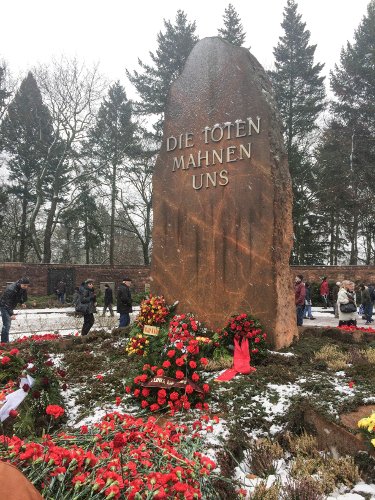
The automobile industry can serve as an illustrative example of this. The already enormous competitive pressure will continue to increase in view of further increases in global overcapacity, endangering production sites and jobs. Current developments in the industry – China’s switch to e-mobility, job losses in manufacturing due to automation, diesel scandals and the foreseeable end of the combustion engine, “digitalization” and “autonomous driving” and new competition from tech giants will completely change the industry. As a preventive measure, state capital assistance would have to be bound to alternative transformative developments as well as to participation in the ownership or full socialization of companies that resist the new necessities. Public participation would have to be combined with the increased participation of employees, trade unions, environmental associations and people from the area. This could be done in regional councils that decide on concrete steps toward converting the automotive industry into an ecologically-oriented service provider for public transportation. Automotive workers at risk of losing their jobs could use these councils to discuss, develop and determine how a conversion of their industries and a just transition could be organized. Trade unions must also take up this urgent task. In this way, the different social groups concerned within the company or in the region itself can become protagonists of change. A socio-ecological transformation fund could provide the necessary resources. The transformation of transport must be implemented against corporate interests, but together with the employees and their families: they too have an interest in the “compatibility” of adequate living conditions, in having time for family and friends and in a natural environment worth living in for themselves and their children. Some of the main goals would be the end of the combustion engine by 2030 (reducing car production to 50%) and the far-reaching realization of car-free inner cities through a massive expansion of public transport and corresponding infrastructure in urban and rural areas.
This will not always mean that employees will be able to remain in the same company or sector. To make sure that a socio-ecological transformation is not feared (or even combated by those affected), guarantees are needed in addition to positive perspectives and participation. US Representative Alexandria Ocasio-Cortez and US Senator Bernie Sanders have therefore included a job guarantee in their proposal for a Green New Deal (referring to Roosevelt’s New Deal). Because the transformation requires an incredible amount of labour power. Everyone who wants work should have the right to publicly funded, collectively agreed and unionized work with “short full time.”7 At the same time, such a guarantee would better distribute labour, break the power of capital to dictate the terms of labour, and put an end to precarity.
Solidarity or Barbarism
Really, capitalism as it exists today is a failed enterprise. Socialism or barbarism, as Rosa Luxemburg once called it as she watched the world sink into imperialism, colonialism and World War I (later World War II and the Holocaust) are the only alternatives. Barbarism has once again become a real and threatening possibility in the face of problems piling up at the feet of humanity – globally rampant social inequality, an ecological catastrophe that is already underway, war and mass migrations.
There must be disputes within the left. The question is how they are conducted. Is it first and foremost directed at the opponent within the party, thus splitting and weakening Die Linke? Or are the disputes conducted through solidarity, in a comradely way? Is the goal to connect people and bring them together? In periods when a movement or party is on the rise, it is possible to keep the conflicting elements and opposites together in a coherent way. In periods when a party is in decline or stagnating, this becomes much more difficult; in-fighting increases as dynamics disintegrate. But it is possible to effect a renewal that dissolves existing blockages and develops more productive approaches. There are plenty of examples of this. It all depends on the concrete constellation, but also on whether a party is ready at the right moment. Let us jump into the unknown with joy and confidence, while remaining aware of the reality of the situation. •
[Translation: Hunter Bolin & Marty Hiatt for Gegensatz Translation Collective.]
Endnotes
- On the special features of these elections see Kahrsa, Horst, “Die Landtagswahlen in Brandenburg und Sachsen 2019,” Rosa-Luxemburg-Stiftung (ed.), September 2019; Die Linke, “Bundesgeschäftsstelle: Wahlnachtberichte Brandenburg & Sachsen,” 2.9.2019.
- In a nutshell, the Greens benefit from several factors at once: a) through its attacks on the “filthy green 68ers,” their gender and ecological politics of the “wealthy,” etc., the AfD making the Greens the natural representative of the third pole; b) the Greens were able to embody those counter-positions (regardless of their real politics in government) during the European elections, when fears of the further rise of the radical right had a mobilizing effect, while left-wing voter potential was typically of little interest and could hardly be mobilized (1.1 million voters who voted for Die Linke in 2014 did not vote in the European elections this time around); c) last autumn, climate or ecological issues became more prominent in public debate, beginning with the occupation of Hambacher Forest, which had astounding resonance, thanks to the continued efforts of the anti-coal movement, and above all, of course, through the actions of Fridays for Future. Even if Die Linke’s social-ecological politics has since become more advanced than that of the Greens, “climate competence” is still publicly attributed to the Greens; d) in the East, the results for the Greens lagged behind the polls, but nevertheless as the declared Western party, in Brandenburg they were elected for the first time to the state parliament in double figures, above all because of concerns about climate change and right-wing developments. The Greens are particularly strong among young voters and the more highly educated. In both Saxony and Brandenburg, there is the prospect of entering into coalition negotiations and assuming government responsibility. The situation was different in the state of Thuringia, where the Left was able to represent the third pole due to its popular Prime Minister, and won the elections.
- Cf. Ehling, Janis, “Die Linke: Verlust der Arbeiterklasse?,” in: Die Freiheitsliebe, 11.8.2019.
- Luxemburg, Rosa, “Karl Marx” [1903], in Gesammelte Werke, Vol. 1.2, Berlin 1988, pp. 369-377, here 373 (in English).
- Brie, Michael, and Candeias, Mario, “Rückkehr der Hoffnung: Für eine offensive Doppelstrategie,” in: LuXemburg-online, November 2016; Brie, Michael, and Candeias, Mario, “Linkspartei: Gegen das politische Vakuum,” in: Blätter für deutsche und internationale Politik 11/2017, pp. 81–86.
- The CDU/CSU is uncertain about how to get its right-wing voters back from the AfD and at the same time embody the party of the centre, whether it should take the path of an ultraliberal and authoritarian Macron or pursue ecological modernization with limited social cushioning.
- Becker, Lia, and Riexinger, Bernd, “For the many not the few: Gute Arbeit für Alle! Vorschläge für ein Neues Normalarbeitsverhältnis,” in Sozialismus 9/2017, supplement.


